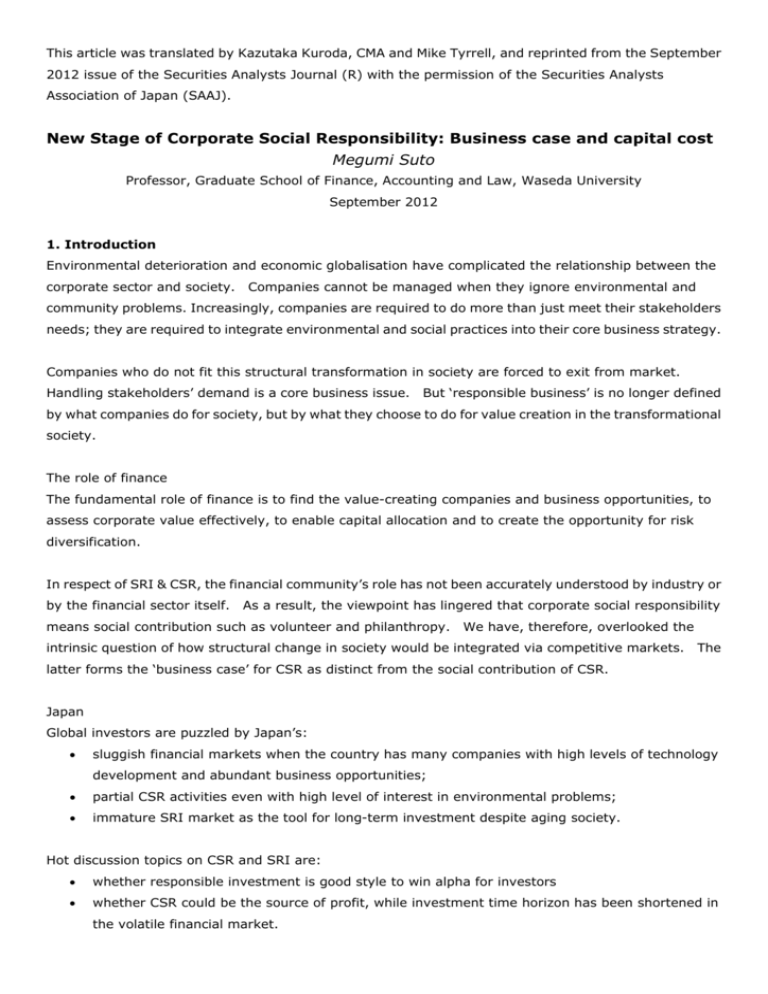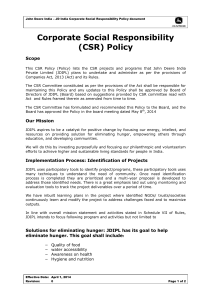Prospects New Stage of Corporate Social Responsibility
advertisement

This article was translated by Kazutaka Kuroda, CMA and Mike Tyrrell, and reprinted from the September 2012 issue of the Securities Analysts Journal (R) with the permission of the Securities Analysts Association of Japan (SAAJ). New Stage of Corporate Social Responsibility: Business case and capital cost Megumi Suto Professor, Graduate School of Finance, Accounting and Law, Waseda University September 2012 1. Introduction Environmental deterioration and economic globalisation have complicated the relationship between the corporate sector and society. Companies cannot be managed when they ignore environmental and community problems. Increasingly, companies are required to do more than just meet their stakeholders needs; they are required to integrate environmental and social practices into their core business strategy. Companies who do not fit this structural transformation in society are forced to exit from market. Handling stakeholders’ demand is a core business issue. But ‘responsible business’ is no longer defined by what companies do for society, but by what they choose to do for value creation in the transformational society. The role of finance The fundamental role of finance is to find the value-creating companies and business opportunities, to assess corporate value effectively, to enable capital allocation and to create the opportunity for risk diversification. In respect of SRI & CSR, the financial community’s role has not been accurately understood by industry or by the financial sector itself. As a result, the viewpoint has lingered that corporate social responsibility means social contribution such as volunteer and philanthropy. We have, therefore, overlooked the intrinsic question of how structural change in society would be integrated via competitive markets. The latter forms the ‘business case’ for CSR as distinct from the social contribution of CSR. Japan Global investors are puzzled by Japan’s: sluggish financial markets when the country has many companies with high levels of technology development and abundant business opportunities; partial CSR activities even with high level of interest in environmental problems; immature SRI market as the tool for long-term investment despite aging society. Hot discussion topics on CSR and SRI are: whether responsible investment is good style to win alpha for investors whether CSR could be the source of profit, while investment time horizon has been shortened in the volatile financial market. There is currently a huge gap of understanding in the direction of global research direction on CSR/SRI and of Japanese SRI market. 2. New Approach to CSR Research Deadlock in CSR Research Although corporate role and responsibility in society has been discussed since 1970, there has been no consensus on the concept and definition of CSR: Some argue that CSR is about striking a balance between social justice and profit seeking Others argue that CSR is a tool for creating sustainable businesses. In the 2000s, there was considerable discussion over whether financial performance and social reputation were compatible and how social performance and economic performance were linked. A number of quantitative analyses on the relationship between corporate social performance (CSP) and corporate financial performance (CFP) were conducted. Research was also conducted on SRI and investment return. Many of them focussed on the advantages of SRI relative to traditional investment styles. Again, the varied methodology and results resulted in further discussions on the drawbacks of research methodology and interpretation of the research results. Proponents of CSR and SRI tried to explain away negative results, while opponents of CSR welcomed the negative results and based their criticism of the positive results on the research methodology and time periods selected. The lack of a clear link between CSP and CFP fuelled scepticism of the whole area. In retrospect, I think we must now acknowledge that much research into was CSR and Corporate Financial Performance (CFP) was immature - even in the middle of 2000s – and that the focus on whether there is a link between CSR and corporate value provided a weak theoretical background. CSR Business Model and Incentive Research into CSR changed significantly in the late 2000s as the focus shifted from trying to understand whether there was a link between CSP and CFP to focus instead on the route and mechanism by which CSR activities were connected with CFP. This raised three issues which has not been previously considered: First, research focused on the casual relationship and interactivity between CSP and CFP. Previous research on CSR activities focussed on the amount of money for philanthropy and volunteer without the explanation and validation of the objectives and estimated effects. This had the effect of presenting CSR as irrelevant to core business practice Secondly, the focus on ‘route’ and ‘mechanism’ between CSR activities and results resulted in closer attention to on the question of ‘incentive’. This matters when we consider the procedure of integration of ESG into core business beyond legal compliance. Thirdly, lack of interest in the route, mechanism and incentive had allowed us to use simple CSR KPIs. This led to uncontrollable quantitative analyses. Quantitative analyses on CSP and CFP were conducted with easily-available CSR rankings, indices and KPIs without attention to the meaning of these indicators. The identification of ‘route’ and ‘mechanism’ which recognises CSR as an incentive in the management is promoting strategic actions and removes the ambiguity. Rapidly Developing Global Standards Global analysts regard the CSR activities of Japanese companies as partial and insufficiently disclosed. They excel in environmental issues and social contribution. However, they are not aware of and do not disclose sufficient information on the risks related to human rights, labour practice, fair operating practice and supply chain management. The awareness gap between Japanese companies and the investors has widened. Economic globalisation (supported by standards such as ISO26000 and the Dodd-Frank Act) will bring further focus on these issues and on companies’ codes of conduct. 3. Corporate Social Performance (CSP) and Corporate Financial Performance (CFP) CSR and Stakeholder Management As discussed in the previous chapter, quantitative analyses that connect corporate performance with CSR indicators confuse the discussion on CSR. Companies maintain relationships with a wide variety of stakeholders such as shareholders, debtors, employees, consumers, business partners, and communities. CSR activity is the relationship management with a variety of stakeholders, stakeholder relationship management. In reality, many Japanese companies have already disclosed CSR information by stakeholder in their CSR reports. However, they rarely provide us with any explanation as to how the management of these relationships affect their CFP. Corporate organisation differs in industries and development stages. Stakeholders are not identical and stakeholder relationship needed to be prioritised differs in industries and between mature and emerging companies. Identification of the relationship between CSP and CFP is based on the confirmation of the relationship between companies’ response to each stakeholder and expected results. Routes and Drivers Connecting CSP with CFP CSR activities by stakeholder are classified into some discussion topics. I discuss stakeholder management with employees (internal management), customers/clients, supply chain (business partners), community, environment, and governance. Firstly, I discuss employee relationship and internal management. Employees are key members and companies’ capital. There is a growing trend of employee engagement as the source of competitive advantage and investment in intangible assets such as wage and reward system, transparency in promotion system, health & safety in workplace, work-life balance. Additionally employee engagement is recognised as corporate attitude towards CSR such as society, environment and human rights and has impacts on the reputation for external stakeholders, since corporate responses to environment and society are integrated into employees’ activities through internal management and training. o Employee activities are a key driver to connect CSP with CFP in terms of quality of human capital and dispatch of information. However employee engagement has not been properly integrated into CSR strategy, although companies recognise the significance of employee engagement and significance of training. The models between employee motivation and activity are necessary. Secondly, I discuss customer activities and customer management. Customers are interested in product quality, environmental labels of products, and operational environmental impact, and ask corporate disclosure on these issues, as well as purchase final products. Customer relationship management is directly connected with corporate value, since final consumers are end users of products from all industries. Customers are the influential driver on corporate performance through their reputation. Thirdly, I discuss supply chain management and impact on trade chain. Many Japanese companies are integrated into global trade chain by overseas expansion and trade globalisation. The chain management should be called value chain management, since a part of the chain could have a negative impact on the whole. No company could keep competitive advantage without the recognition where it is positioned in the chain. It is essential to consider society and environment beyond legal requirement in the specific area and country and to share the information with business partners. The background of economic theories such as anonymous market is no longer applicable. Fourthly, I discuss social relationship management, building the relationship with community and global society. Sensitivity and response to social needs improve corporate reputation and contribute to the accumulation of social capital. However, social requirement has been actually strengthened and varied. Each company has the limitation of the response and is required to decide the response. The key is the company’s capacity of communication, information collection and disclosure. Then I discuss corporate commitment against environment and environmental management. Generally environmental management is essential as the source of business opportunity in many industries, as well as reputation and trust in society. Energy saving and pollution control actually motivated the improvement in production process and product development, and the innovation for resource saving, in automobile manufacture and electrical equipment sectors which obviously have major environmental impacts. Regarding the relationship between environmental management and CFP, some research showed positive relationship between operational efficiency and share price, while others demonstrates cost increase. However effort on environmental management is relatively visible and therefore could be an effective driver linked to CFP. Finally I discuss upgrade of governance system in relation to shareholders and governance management. Needless to say, risks for long-term investors and shareholders are integrated risks managements face. Error in stakeholder management and insufficient non-financial disclosure would expand CSR-related risks, and then operational and financial risks. Adequate handle with social and environmental problems would lower risks and potential cost. Proper internal control and disclosure would lower risk premium required by shareholders, and capital cost and interest rate through minimisation of the information gap between corporate management and shareholders. The positive attitude towards information disclosure and accountability to external stakeholders is interpreted as a signal to minimise the gap between corporate management and shareholders. Non-financial disclosure is the core factor to determine finance cost. Shareholders should be a driver to connect CSP and CFP in capital markets. 4. CSR Risk Management and Capital Cost There should be a general consensus that social and environmental issues present one of the major sources of business uncertainty. Financial professionals should recognise that the recent CSR research covers the relationship between the perception of market participants on CSR and capital cost. In other words, managers’ incentives and the financing and role of financial markets are subjects for critical scrutiny. However, research on the relationship between CSR risk and capital cost has been done mainly by academic experts in accounting. Little research has been done by experts in financing with most of this focussed on CSP and CFP from the viewpoint from investors and shareholders. The topic that remains is the relationship between corporate finance activities and market valuation. More research from corporate finance viewpoint is needed. Consideration of non-financial attributes in corporate risk management will offer us to reach new stage on determinant analyses of capital cost – particularly as risk management to lower the capital cost is one of the main areas for company managers to consider. Practical problem of CSR research is how to integrate CSR into core management. It is difficult that companies are not incentivised to be involved in CSR only with social responsibility and welfare. Shareholders and long-term investors must distinguish effective CSR practices from executives’ lip service and formative CSR practices. More research is needed on corporate and executive incentivisation around CSR activities. Megumi Suto Her major fields are Corporate Governance, Corporate Social Responsibility, and Financial Systems. She is a member of editorial committee of Securities Analysts Journal of Japan and a board member of Social Investment Forum Japan (SIF-Japan).







